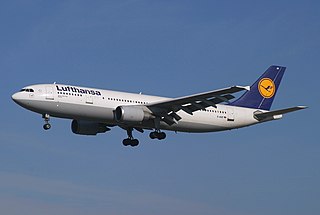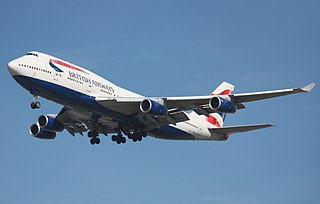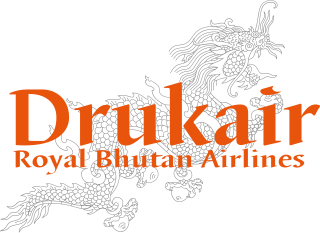
The Airbus A300 is a wide-body airliner developed and manufactured by Airbus. In September 1967, aircraft manufacturers in the United Kingdom, France, and West Germany signed a memorandum of understanding to develop a large airliner. West Germany and France reached an agreement on 29 May 1969 after the British withdrew from the project on 10 April 1969. European collaborative aerospace manufacturer Airbus Industrie was formally created on 18 December 1970 to develop and produce it. The prototype first flew on 28 October 1972.

The Boeing 767 is a wide-body airliner developed and manufactured by Boeing Commercial Airplanes. The airliner was launched as the 7X7 project on July 14, 1978, the prototype first flew on September 26, 1981, and it was certified on July 30, 1982. The original 767-200 entered service on September 8, 1982 with United Airlines, and the extended-range 767-200ER in 1984. It was stretched into the 767-300 in October 1986, followed by the 767-300ER in 1988, the most popular variant. The 767-300F, a production freighter version, debuted in October 1995. It was stretched again into the 767-400ER from September 2000.

The Boeing 747 is a large, long-range wide-body airliner manufactured by Boeing Commercial Airplanes in the United States. After introducing the 707 in October 1958, Pan Am wanted a jet 2+1⁄2 times its size, to reduce its seat cost by 30% to democratize air travel. In 1965, Joe Sutter left the 737 development program to design the 747, the first twin aisle airliner. In April 1966, Pan Am ordered 25 Boeing 747-100 aircraft and in late 1966, Pratt & Whitney agreed to develop its JT9D engine, a high-bypass turbofan. On September 30, 1968, the first 747 was rolled out of the custom-built Everett Plant, the world's largest building by volume. The first flight took place on February 9, 1969, and the 747 was certified in December of that year. It entered service with Pan Am on January 22, 1970. The 747 was the first airplane dubbed a "Jumbo Jet", the first wide-body airliner.

The Boeing 777, commonly referred to as the Triple Seven, is an American wide-body airliner developed and manufactured by Boeing Commercial Airplanes. It is the world's largest twinjet. The 777 was designed to bridge the gap between Boeing's 767 and 747, and to replace older DC-10s and L-1011s. Developed in consultation with eight major airlines, with a first meeting in January 1990, the program was launched on October 14, 1990, with an order from United Airlines. The prototype was rolled out on April 9, 1994, and first flew on June 12, 1994. The 777 entered service with the launch customer, United Airlines, on June 7, 1995. Longer range variants were launched on February 29, 2000, and were first delivered on April 29, 2004.

The Airbus A310 is a wide-body aircraft; designed and manufactured by Airbus Industrie, then a consortium of European aerospace manufacturers. Airbus had demand for an aircraft smaller than the A300, the first twin-jet wide-body. On 7 July 1978, the A310 was launched with orders from Swissair and Lufthansa. On 3 April 1982, the first prototype conducted its maiden flight, and it received its type certification on 11 March 1983.

The Airbus A320 family are narrow-body airliners designed and produced by Airbus. The A320 was launched in March 1984, first flew on 22 February 1987, and was introduced in April 1988 by Air France. The first member of the family was followed by the longer A321, the shorter A319, and the even shorter A318 . Final assembly takes place in Toulouse in France; Hamburg in Germany; Tianjin in China since 2009; and in Mobile, Alabama in the United States since April 2016.

The Airbus A380 is a wide-body aircraft manufactured by Airbus. It is the world's largest passenger airliner. Airbus studies started in 1988, and the project was announced in 1990 to challenge the dominance of the Boeing 747 in the long haul market. The then-designated A3XX project was presented in 1994; Airbus launched the €9.5 billion ($10.7 billion) A380 programme on 19 December 2000. The first prototype was unveiled in Toulouse on 18 January 2005, with its first flight on 27 April 2005. Difficulties in electrical wiring caused a two-year delay, and the development cost ballooned to €18 billion. It obtained its type certificate from the European Aviation Safety Agency (EASA) and the US Federal Aviation Administration (FAA) on 12 December 2006.
Biman Bangladesh Airlines, commonly known as Biman, pronounced, is the national flag carrier of Bangladesh. With its main hub at Hazrat Shahjalal International Airport in Dhaka, the airline also operates flights from its secondary hubs at Shah Amanat International Airport in Chittagong and as well as Osmani International Airport in Sylhet. The airline provides international passenger and cargo services to multiple destinations and has air service agreements in 42 countries. The headquarters of the airline, Balaka Bhaban, is located in Kurmitola, in the northern part of Dhaka. Annual Hajj flights; transporting tourists, migrants and non-resident Bangladeshi workers; and the activities of its subsidiaries form an integral part of the corporate business of the airline. Bangladesh's air transport sector, which is experiencing an 8% annual growth rate thanks to a large number of outbound tourists, domestic tourists and non-resident Bangladeshi travellers, is very competitive with stiff competition among a number of private Bangladeshi airlines as well as Biman.

The Bristol Type 175 Britannia was a British medium-to-long-range airliner built by the Bristol Aeroplane Company in 1952 to fly across the Commonwealth. During development two prototypes were lost and the turboprop engines proved susceptible to inlet icing, which delayed entry into service while solutions were sought.
Virgin Australia, the trading name of Virgin Australia Airlines Pty Ltd, is an Australian-based airline. It is the largest airline by fleet size to use the Virgin brand. It commenced services on 31 August 2000 as Virgin Blue, with two aircraft on a single route. It suddenly found itself as a major airline in Australia's domestic market after the collapse of Ansett Australia in September 2001. The airline has since grown to directly serve 33 cities in Australia, from hubs in Brisbane, Melbourne and Sydney.

The Boeing 747-400 is a wide-body airliner produced by Boeing Commercial Airplanes, an advanced variant of the initial Boeing 747. The "Advanced Series 300" was announced at the September 1984 Farnborough Airshow, targeting a 10% cost reduction with more efficient engines and 1,000 nmi (1,850 km) more range. Northwest Airlines (NWA) became the first customer with an order for 10 aircraft on October 22, 1985. The first 747-400 was rolled out on January 26, 1988, and made its maiden flight on April 29, 1988. Type certification was received on January 9, 1989, and it entered service with NWA on February 9, 1989.
Qatar Airways Company Q.C.S.C., operating as Qatar Airways, is the state-owned flag carrier of Qatar. Headquartered in the Qatar Airways Tower in Doha, the airline operates a hub-and-spoke network, flying to over 150 international destinations across Africa, Asia, Europe, the Americas, and Oceania from its base at Hamad International Airport, using a fleet of more than 200 aircraft. Qatar Airways Group employs more than 43,000 people. The carrier has been a member of the Oneworld alliance since October 2013, the first Persian Gulf carrier to sign with one of the three major airline alliances.
Singapore Airlines operates a predominantly widebody fleet, until the re-introduction of the Boeing 737-800 & MAX-8 Series in March 2021 following the merger with SilkAir. The airline also operates Boeing 747-400 freighters. As of 1 September 2021, there were 153 passenger aircraft and seven freighters registered in the Singapore Airlines fleet.

Drukair Corporation Limited, operating as Drukair — Royal Bhutan Airlines, is the flag carrier of the Kingdom of Bhutan, headquartered in the western dzongkhag of Paro.
Armavia was an airline that existed between 1996 and 2013. It was Armenia's flag carrier, with its head office on the grounds of Zvartnots International Airport in Zvartnots, Armenia, near Yerevan. It operated international passenger services from Yerevan to destinations in Europe and Asia. Its main base was Zvartnots International Airport.

Federal Express Corporation, branded as FedEx Express, is a major American cargo airline based in Memphis, Tennessee, United States. As of 2020, it is one of the world's largest airlines in terms of fleet size and freight tons flown. It is the namesake and leading subsidiary of FedEx Corporation, delivering freight and packages to more than 375 destinations over 220 countries across six continents each day. FedEx Express is also the world's largest express transportation company.
UPS Airlines is a cargo airline based in Louisville, Kentucky. The fourth-largest cargo airline worldwide, UPS Airlines flies to 815 destinations worldwide. A wholly owned subsidiary of UPS since its launch in 1988, the airline marked its 30th year of operation in 2018.

The Mitsubishi SpaceJet is a regional jet developed by Mitsubishi Aircraft Corporation (MAC), a Mitsubishi Heavy Industries (MHI) subsidiary. MHI first announced the concept in June 2007, then targeting certification for 2012, as the first Japanese airliner since the 1962 NAMC YS-11. After a delayed development, the maiden flight of the MRJ90 took place on 11 November 2015. In June 2019, Mitsubishi rebranded the Mitsubishi Regional Jet program as the SpaceJet. As flight testing was longer than expected, service entry was pushed back until development was paused amid the impact of the COVID-19 pandemic on aviation.

The Airbus A320neo family is a development of the A320 family of narrow-body airliners produced by Airbus. The A320neo family is based on the previous A319, A320 and A321, which was renamed to A320ceo, for "current engine option".













